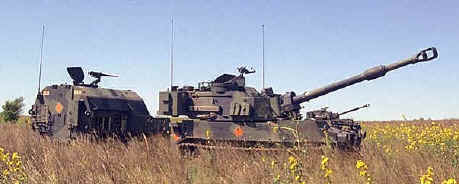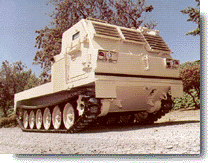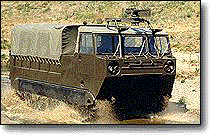In
1948, famous British military historian B. H. Liddell Hart wrote about his
post-war interviews with German Generals in a book "The German Generals
Talk". In Chapter 8 he writes about the 1941 German invasion of the
Soviet Union: "The Germans lost
the chance of victory because they had based their mobility on wheels instead of
on tracks. On these mud-roads the wheeled transport was bogged when the
tanks could move on. Panzer forces with tracked transport might have
overrun Russia's vital centres long before autumn, despite the bad roads.
World War I had shown this need to anyone who used his eyes and his
imagination."
He later wrote that even though the German army was modern, "it had not yet caught up with ideas that were twenty years old." Apparently, the US Army will relearn lessons that are now 80 years old since it has no tracked resupply vehicles for its armored forces. This is very important for the M1A1 Abrams tank, whose gas turbine engine burns three times more fuel per mile than traditional diesels, and it only carries 40 rounds for its 120mm main gun. Tank commanders will not want to push forward if they have only ten rounds left, or even twenty.
Each US Army M109A6 155mm howitzer has a tracked
FAASV supply buddy to keep it in action (above). Tanks needs something
similar, perhaps the same FAASV design. A tracked vehicle to move bulk
liquids is also needed for fuel and water. 
 Two
M113 armored personnel carrier variants have already been modified for logistical
support: the XM1108 (left) and the M548A3 (right). However, neither has an
armored cargo section, and are found in just a few support units.
Forklifts are extremely useful in loading trucks which explains why the armored
sides were removed. Perhaps the larger Bradley with its powerful engine
could also be modified to carry cargo with pop up armored sides like garage
doors. Some could just be fitted
with a removable bladder, making it easy to shift from water to fuel depending
on the tactical situation. Bradleys will prove more useful supplying
tanks with ammo and fuel than with 25mm chain gun and TOW fire support.
Two
M113 armored personnel carrier variants have already been modified for logistical
support: the XM1108 (left) and the M548A3 (right). However, neither has an
armored cargo section, and are found in just a few support units.
Forklifts are extremely useful in loading trucks which explains why the armored
sides were removed. Perhaps the larger Bradley with its powerful engine
could also be modified to carry cargo with pop up armored sides like garage
doors. Some could just be fitted
with a removable bladder, making it easy to shift from water to fuel depending
on the tactical situation. Bradleys will prove more useful supplying
tanks with ammo and fuel than with 25mm chain gun and TOW fire support.
The US Army recently downsized its armored units from four companies to three. This was done to lessen logistical demands for expeditionary operations, and to preserve units. If any army wants truly mobile armored forces, it should add a tracked logistics company to each armored battalion. A typical "Log" company could consist of 16 tracked vehicles: six fuel, four ammo, two rescue, two maintenance, and two water/food variants. The rescue variants will pull up to a damaged tank in combat and allow medics in fireproof suits pull out wounded before they are engulfed in fire. During World War II, it was common for mechanics to repair tanks while engagements continued. Armored tracked mechanics variants can pull up to tanks minutes after they are immobilized by breakdowns or enemy fire. TLAV has proposed such variants for the M113.
This Log company is far too small to resupply an entire battalion at once, but it can immediately support key elements near enemy forces. Vehicles can then dash toward the rear to load more supplies. This is far better than requiring combat units to withdraw to the nearest road in rough or muddy terrain. Tracked vehicle resupply can double the combat power of armored units by providing them supplies and support to keep them in action.
Carlton Meyer editorG2mil@Gmail.com
©2002 www.G2mil.com